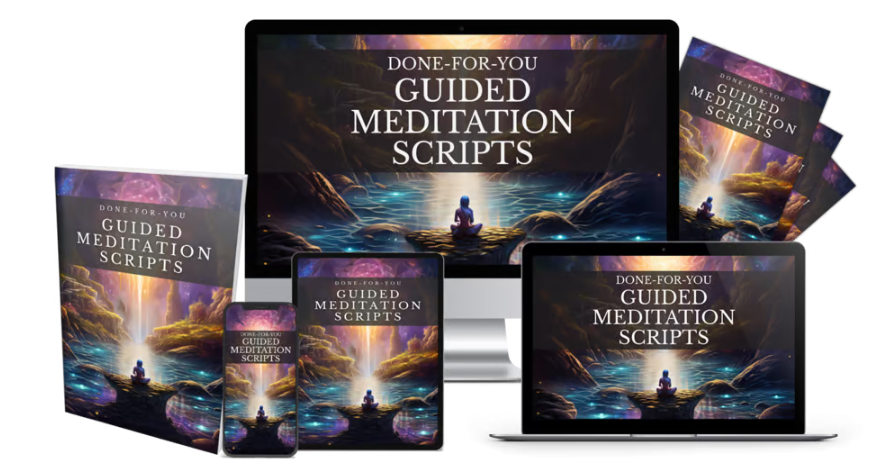When you create your sanctuary through guided meditation, you open the door to a world of inner peace and relaxation. Imagine visualizing a serene beach or a tranquil forest, allowing each detail to wash over you. As you engage your senses, you’ll find that these mental escapes can significantly enhance your emotional well-being. Yet, the journey doesn’t stop at simple visualization; there’s much more to explore about how you can integrate these practices into your daily life. Curious about how to transform your environment into a consistent source of calm?
Benefits of Guided Meditation
Guided meditation offers several key benefits that can transform your daily routine.
First, it helps reduce stress and anxiety. When you listen to a calming voice directing your focus, you can let go of worries and embrace a sense of tranquility. You’ll find that even short sessions can significantly lighten your mental load.
Second, guided meditation enhances your focus and concentration. By following a structured session, you train your mind to hone in on specific thoughts or imagery. This practice improves your ability to maintain attention in other areas of your life, making tasks feel more manageable.
Additionally, it cultivates self-awareness. As you engage with guided imagery, you gain insights into your feelings, thoughts, and behaviors. This awareness empowers you to make conscious choices, fostering a more balanced emotional state.
Lastly, guided meditation promotes better sleep. By dedicating time to unwind with soothing guidance, you signal your body that it’s time to relax and let go of the day’s stresses.
You’ll likely notice a significant improvement in the quality of your sleep, which further enhances your overall well-being. Embrace these benefits, and watch your daily life transform.
Preparing Your Mind for Meditation
To make the most of the benefits guided meditation offers, preparing your mind beforehand is key. Start by finding a quiet space where you won’t be interrupted. This physical environment sets the tone for your mental journey.
Take a moment to sit comfortably, allowing your body to relax.
Next, focus on your breath. Inhale deeply through your nose, holding for a count of four, then exhale slowly through your mouth. This simple practice helps clear your mind of distractions and brings you into the present moment.
Acknowledge any thoughts or worries that arise, but don’t dwell on them. Instead, gently guide your attention back to your breath. You might even visualize each exhale as a release of tension, making space for peace.
Consider setting an intention for your meditation. What do you want to cultivate in your mind? It could be calmness, clarity, or joy. This intention will serve as a guiding light during your session.
Visualization Techniques for Peace
Visualization techniques can be a powerful tool for cultivating inner peace during meditation. When you close your eyes, imagine yourself in a serene setting—perhaps a tranquil beach or a quiet forest. Picture the gentle waves lapping at the shore or the soft rustle of leaves in the breeze. Let these images fill your mind.
As you visualize, engage all your senses. Feel the warmth of the sun on your skin or the coolness of the earth beneath your feet. Listen to the soothing sounds around you, letting them wash over you like a comforting wave. This immersive experience helps ground you, allowing stress and anxiety to melt away.
You can also visualize colors associated with peace—soft blues, gentle greens, or warm whites. Imagine these colors enveloping you, creating a protective cocoon that shields you from negativity.
Breathe deeply, inhaling peace and exhaling tension.
Sample Meditation Scripts
Crafting effective meditation scripts can enhance your practice, guiding you towards deeper relaxation and mindfulness.
Here’s a sample script to help you visualize a peaceful sanctuary.
Begin by finding a comfortable position. Close your eyes and take a deep breath in through your nose, then exhale slowly through your mouth.
Picture yourself in a serene garden filled with vibrant flowers. Notice the colors and scents surrounding you.
As you walk through the garden, feel the soft grass beneath your feet. Hear the gentle rustle of leaves and the distant sound of a babbling brook. Allow the calming atmosphere to wash over you, releasing any tension in your body.
Now, imagine finding a cozy bench under a blooming tree. Sit down and feel the warmth of the sun on your skin.
Take a few moments to breathe deeply, embracing the tranquility of this space.
When you’re ready, slowly bring your awareness back to the present moment. Wiggle your fingers and toes, then gently open your eyes.
Carry this sense of peace with you throughout your day.
Integrating Meditation Into Daily Life
Integrating meditation into your daily life can transform ordinary moments into opportunities for mindfulness and calm. Start by carving out a few minutes each day for meditation, even if it’s just five minutes. You can sit quietly in the morning, enjoy a moment of stillness during lunch, or wind down in the evening.
Incorporate mindfulness into routine activities. When brushing your teeth, focus on the sensations and sounds. While walking, notice your breath and the rhythm of your steps. These small practices keep you grounded and present.
Use guided meditation apps or videos to help you stay committed. Set reminders on your phone for short meditation breaks throughout the day.
You can also create a peaceful space in your home, a designated area for meditation that invites tranquility.
Conclusion
Incorporating Guided meditation scripts into your routine can transform your mental landscape, creating a personal sanctuary where you find peace and balance. By visualizing serene spaces and practicing regularly, you nurture your well-being and enhance your emotional resilience. Remember, it’s about making time for yourself and embracing the calm within. So, take a deep breath, let your mind wander to your tranquil space, and enjoy the profound benefits that come with this practice. Your sanctuary awaits!

